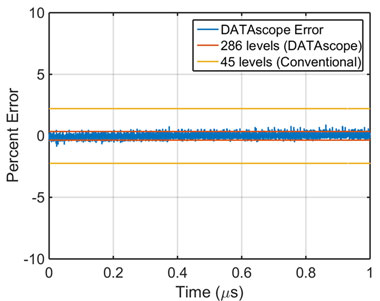Jason Chou (15-ERD-056)
Project Description
Electronic signal processors are essential to military, industrial, and experimental needs in radar, communications, and diagnostics. Today's electronic processors used to convert analog signals into digital format are limited by a fundamental trade-off between resolution and speed, known as the "digital bottleneck." This digital bottleneck is rooted in device physics of the electronic converter (i.e., timing jitter), resulting in high-amplitude noise with frequency. Hence, electronic analog-to-digital conversion can achieve either high resolution or high speed, but not both. We are developing an entirely new processor—one based on photonics—that can break through these barriers and provide fivefold to tenfold higher performance for applications in national security, research, and telecommunications. Our patented photonic processor, called DATAscope, utilizes optical mapping technology that converts amplitude information into the time domain, where it can be quantized with significantly higher resolution. For example, a standard 6-GHz oscilloscope offers only 45 effective levels of resolution, while our technique promises to offer over 500 effective levels across the same bandwidth.
We expect to demonstrate that DATAscope can digitize continuous or single-shot analog input signals with 512 effective levels of resolution at a sample rate of 12 GHz. This goal is significant because, not only will it set a new record in resolution-bandwidth products, it will provide a high-fidelity, real-time temporal diagnostic needed to measure laser pulse characteristics delivered to the target in advanced fusion-class lasers. Moreover, this goal has direct application to military systems that require high-resolution and high-speed analog-to-digital converters for radar and electronic warfare. Finally, the technology has licensing opportunities in the telecommunications industry that could enable more sensitive and cost-effective wireless networks. Our photonic processor concept can be described in three basic steps. First, amplitude information is encoded in time by an ultrafast tunable optical filter, which maps analog information into wavelength. Second, a low-loss dispersive element maps wavelength information into time. Third, a data-processing step decodes the input amplitude by analyzing the time-encoded data.
Mission Relevance
Our proposed capability to achieve a fivefold to tenfold improvement in resolution for high-fidelity temporal diagnostics to measure laser pulse characteristics is well aligned with Livermore's core competency in lasers and optical science and technology by contributing to the design of future high-energy and high-peak-power laser systems.
FY16 Accomplishments and Results
To reach a goal of 6 gigasamples per second and 256 effective levels of resolution, in FY16 we have (1) improved our computational codes to increase the yield of raw data files, a factor previously limiting the statistics of experimental data; (2) developed a more sophisticated end-to-end model to better understand existing performance walls; (3) continued to reduce the quantization noise (from the analog-to-digital conversion) of our digitizer by optimizing our signal amplification architecture; and (4) created a signal-to-noise ratio boost by employing redundant splitters and additional scope channels. The figure summarizes our results.Our FY16 goals of >256 levels of resolution at 6 gigasamples/s were met.






